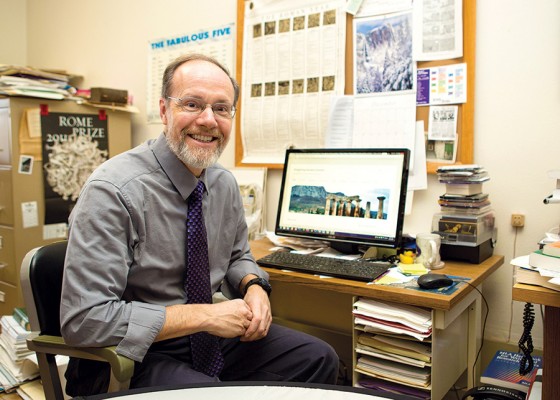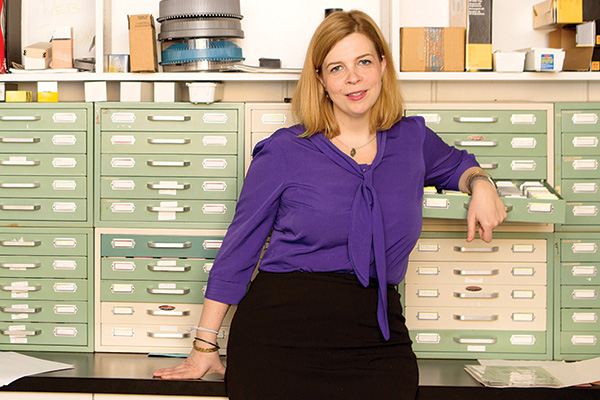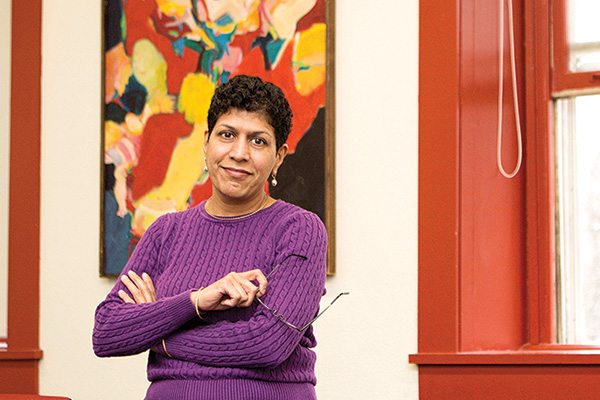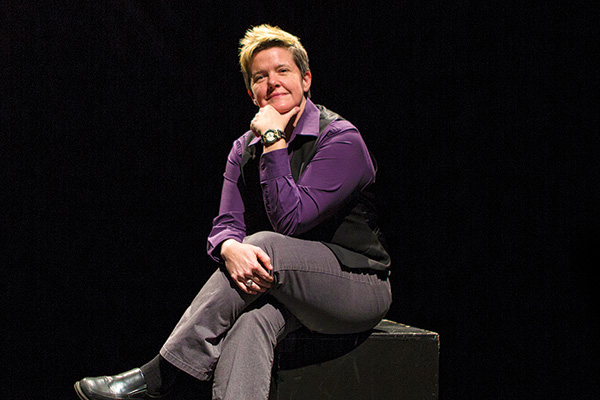Building a time machine to ancient Corinth
Classics Professor John Gruber-Miller is building a time machine.  Or more accurately, he’s giving his students tools to help them make the ancient world come alive—such as constructing a map of Corinth, an ancient Greek city-state that had about 90,000 residents in 400 B.C.
Or more accurately, he’s giving his students tools to help them make the ancient world come alive—such as constructing a map of Corinth, an ancient Greek city-state that had about 90,000 residents in 400 B.C.
“For the past six years, I’ve been working with students in what is now called the Cornell Summer Research Institute on a project called ‘Imagining Ancient Corinth’,” says Gruber-Miller, who was recently elected as vice president of the American Classical League.
“Our goal is to create an online reader geared to intermediate Greek language students, but which is deeper and richer than other intermediate Greek textbooks,” he says. “In effect, we’re creating a digital environment of a long-gone Greek polis (city-state) that integrates a wide range of tools: Greek text, glossaries for unfamiliar words, grammar help, explanatory comments, images of the ancient townscape, essays about culture, myth, and history, and an interactive map that will let students trace Pausanias’ steps through the ancient city.”
During the summer of 2015, classical studies student Miranda Donnellan ’17, computer science professor Ross Sowell, computer science student Joe Sterchele ’17, instructional technology librarian Brooke Bergantzel ’08, and Gruber-Miller attended a conference called the Institute for Liberal Arts Digital Scholarship (ILiADS) at Hamilton College in New York. The institute offers participants an opportunity to develop projects as a team (faculty, student, librarian, technologist, other experts), and also interact with methodology and technology experts who can further their project goals.“Imagining Corinth” uses Book 2 of “Description of Greece,” a tourist guidebook written by Pausanias, a second century A.D. Greek traveler, as its primary source material.
In Book 2, Pausanias describes in significant detail the buildings and environs of ancient Corinth, which had thrived five centuries before he wrote it. The site of ancient Corinth, known to many as a community where Paul visited and established a Christian community, was destroyed by an earthquake in 1858.
“We’re taking what Pausanias wrote about Corinth and turning it into maps and articles, which will be highly illustrated and very interactive,” Gruber-Miller says. “The end product will be an interactive website that will help students of the ancient Greek language explore the mythology, history, and archaeology of Corinth, all the while having fun.”
For Gruber-Miller, creating the project is valuable as a teaching tool in several ways: students claim ownership over their work, have a real audience (rather than imagined), learn to collaborate, and come to comprehend what it takes to create and maintain a digital product—website, interactive map, video, podcast, interactive online reader, and commentary.
“Most students are very adept at using technology,” he says. “But being adept at Facebook or Instagram doesn’t mean you can write or think critically.”
Gruber-Miller was an early adopter of emerging technologies in the classroom.
“This makes the ancient world much more tangible for students in the 21st century. It encourages students to think about the ancient world in comparison to the
21st century United States.”John Gruber-Miller
Professor of Classics
“Writing my Ph.D. dissertation was the first time I had used a computer in my work, and then it was only word processing,” he says. “When I first came to Cornell in 1987, there was a national initiative called the Perseus Project to create a digital classics library. I volunteered Cornell as a test site.” Perseus remains the major digital library of the ancient world.
In 1994, Gruber-Miller copyrighted Scriba, a DOS-based (pre-Windows) tool he developed to supplement the popular Oxford Latin Course, Part I, first edition. Once the tool was functioning, he shared it widely with colleagues around the country.
“After Scriba, I became much more interested in technology as teaching tools,” he says.
Gruber-Miller moved on to develop Ariadne: Resources for Athenaze, a website designed to enhance the teaching of beginning Greek through a wide variety of activities. (Athenaze, which means “to Athens,” is the name of the textbook used in the class.)
“Ariadne is both a language and a culture tool. It uses ancient Greek in a very active way by presenting conversations about topics such as farming in ancient Greece, women’s roles and contributions, how slaves lived, and so on,” he says. “This makes the ancient world much more tangible for students in the 21st century. It encourages students to think about the ancient world in comparison to the 21st century United States. This is a much more holistic tool than Scriba was. It’s an online workbook.”
As he has adopted, adapted, and created technology-based teaching tools for the classics, Gruber-Miller has developed a healthy appreciation for Cornell’s academic environment.
“I can’t overstate the importance of the Summer Research Institute,” he says. “It’s very effective in promoting community building, and it enables students to see what their colleagues and other faculty are working on.
“With the combination of One Course At A Time and the Summer Research Institute, the students learn how to take the initiative, to stay focused, to work with and rely on others, and to understand the importance of teamwork.”
Oh yes, and they’re bringing 2,500-year-old cities back to life.




